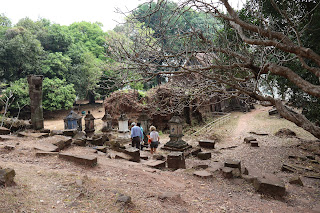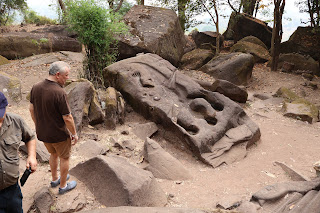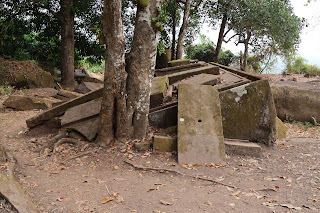Wat Phu (or Vat Phou; Lao: temple-mountain) is a ruined Khmer Hindu temple
complex in southern Laos and one of the oldest places of worship in Southeast
Asia. It is at the base of mount Phou Khao, some 6 kilometres (3.7 mi) from
the Mekong in Champasak Province.
Stretching 1400m up to the lower slopes of the Phu Pasak range (also known
more colloquially as Phu Khuai or Mt Penis), Wat Phu is small compared with
the monumental Angkor-era sites near Siem Reap in Cambodia. But the tumbledown
pavilions, ornate Shiva-lingam sanctuary, enigmatic crocodile stone and tall
trees that shroud much of the site in soothing shade give Wat Phu an almost
mystical atmosphere.
Sanskrit inscriptions and Chinese sources confirm the site has been worshipped
since the mid 5th century. The temple complex was designed as a worldly
imitation of heaven and fitted into a larger plan that evolved to include a
network of roads, cities, settlement and other temples. What you see today is
the product of centuries of building, rebuilding, alteration and addition,
with the most recent structures dating from the late Angkorian period.
At its height the temple and nearby city formed the most important economic
and political centre in the region.
During the last years the local and falang archaeologists have restored the
ceremonial causeway, replacing slabs and re-erecting stone markers that had
been scattered across the site.
The archaeological site itself is divided into six terraces on three main
levels joined by a long, stepped promenade flanked by statues of lions and
nagas.
Lower level
|
Pond (Baray).
A modern sala built by Chao Boun Oum in the 1960s stood at the
western side of the great baray (ceremonial pond;
nawng sa in Lao) until it was dismantled recently, revealing the
sandstone base of the ancient main entrance.
-
From here begins a cause way-style ceremonial promenade, sided by two
baray.
-
Parts of both the northern and southern baray still fill with water,
lotus flowers and the odd buffalo during the wet season and the site
looks better since the stone markers lining the promenade have been
re-erected.
|
|
Platform.
The platform is located between the large pond and the promenade.
|
|
View of the promenade from the platform.
|
|
Promenade.
The promenade is lined with small columns on both sides.
|
|
Small phallic-shaped column.
|
|
Panorama of the promenade and quadrangular pavilions.
|
Middle level
|
Panorama of the quadrangular pavilions.
The middle section features two exquisitely carved, quadrangular
pavilions built of sand stone and laterite.
-
Believed to date from the mid 10th or early 11th century, the style
resembles Koh Ker in Cambodia.
-
Some people (but not the Unesco experts) suggest these pavilions were
used for gender-segregated worship and they are sometimes called ‘lady
pavilion’ and ‘man pavilion’.
-
Wat Phu was converted into a Buddhist site in later centuries but much
of the original Hindu sculpture remains in the lintels, which feature
various forms of Vishnu and Shiva.
|
|
Panorama of the south pavilion.
|
|
Panorama of the north pavilion.
|
|
East end of the north pavilion.
Over the eastern pediment of the north pavilion is a relief of Shiva and
Parvati sitting on Nandi, Shiva’s bull mount.
-
The building consists of four galleries and a central open courtyard,
though entry is forbidden for safety reasons.
|
|
Entering the north pavilion.
|
|
Interior of the north pavilion.
|
|
Restoration work in the north pavilion.
|
|
East end of the south pavilion.
|
|
Door on the north side of the south pavilion.
|
|
South pavilion seen from the northwest.
|
|
Resumption of the processional path.
The processional route started on the platform. It extended, flanked by
small columns, to the quadrangular pavilions. Between the quadrangular
pavilions the processional path opened into a large courtyard. Now, the
processional path resumes its course.
-
At the beginning of this resumption of the processional route is the
statue of a seven-headed snake.
-
At the beginning of this resumption of the processional route is the
statue of a seven-headed snake and the statue of a five-headed
serpent.
-
In front of the seven-headed snake are several containers for candles.
|
|
Continuing to walk along the processional route.
|
|
Restoration work on the processional route.
|
|
Nandi hall.
Just behind the southern pavilion stands a smaller building known as the
Nandi Hall (dedicated to Shiva’s mount) and two collapsed galleries
flanking a set of laterite steps leading to the next level.
-
From the Nandi Hall an ancient royal road once lead south for about
1.3km to Ho Nang Sida, and eventually to Angkor Wat in Cambodia.
|
|
Staircase closed due to poor condition.
The processional route continued along a staircase that is in very poor
condition and is therefore closed.
|
|
The climb is via a side staircase.
|
|
Gate guardian statue (Dvarapala).
An impressive sentinel figure (dvarapala) stands ramrod straight with
sword held at the ready near what was once a gopura (or nate
entranceway).
-
Flower stupas are sold next to the statue to offer to the spirit of
the gate guardian.
-
Chien Tung sticks are available on site to question the gate guardian.
-
A Dvarapala or Dvarapalaka ("door guard") is a door or gate guardian
often portrayed as a warrior or fearsome giant, usually armed with a
weapon - the most common being the mace (gada).
-
See more at
Dvarapala - Wikipedia.
|
|
After the gate guardian, the processional path continues.
|
|
Yoni pedestal and dvarapala statues.
If we step down off the walkway and onto the grassy area just north of
here you’ll come to the remains of a yoni pedestal, the cosmic
vagina-womb symbol associated with Shaivism.
-
Very near the yoni lie two unusually large, headless and armless
dvarapala statues half-buried in the grass.
-
These are the largest dvarapala found anywhere in the former Angkorian
kingdom.
|
|
Steep naga stairway.
A steep naga stairway leads onwards to the sanctuary and probably dates
from the 11th century.
-
It is lined with dawk jampaa (plumeria or frangipani), the Lao
national tree.
|
Upper Level
|
Shiva-lingam Sanctuary.
On the uppermost level is the sanctuary itself, which once enclosed a
Shiva lingam that was bathed – via a system of stone pipes – by waters
from the sacred spring above and behind the complex.
|
|
Shiva-lingam Sanctuary panorama.
|
|
Guardian carved into the pillar.
Guardian carved into the north pillar of the sanctuary's facade.
|
|
Devatas carved on the facade of the sanctuary.
|
|
Lintel over the north door os the facade showing Vishnu riding
Garuda.
Garuda is a Hindu deity who is primarily depicted as the mount (vahana)
of the Hindu god Vishnu.
-
The Garuda are enemies to the naga, a race of intelligent serpent- or
dragon-like beings, whom they hunt.
-
See more at
Garuda: Buddhism - Wikipedia.
|
|
Lintel over the south door of the facade.
|
|
Lintels showing Indra riding his three-headed elephant Erawan.
Erawan is one of the Thai names of Airavata. It is depicted as a huge
elephant with either three or sometimes thirty-three heads which are
often shown with more than two tusks. Some statues show Indra, the king
of Tavatimsa Heaven, riding on Erawan.
-
Airavata is also known for being the cause of the churning of the
ocean of milk. Once sage Durvasa presented a garland to Indra, who
passed it on to Airvata. The elephant then threw the garland on to the
ground, which angered Durvasa and resulted in the demigods to be
"subject to old age and death." Reversing the curse required the devas
to retrieve the nectar of immortality by churning the ocean of milk.
-
See more at
Airavata: Erawan - Wikipedia.
|
|
Lintel showing Vishnu riding Garuda.
|
|
The sanctuary seen from the northwest.
|
|
Lintel over the northern door of the sanctuary showing Indra riding
Garuda.
|
|
Another lintel showing Indra riding Garuda.
|
|
Buddhist statues, in seated positions, table, stones, offerings and
Buddhist relics.
The sanctuary now contains a set of unsophisticated looking Buddha
images on an altar.
-
The brick rear section, which might have been built in the 9th
century, is a cella (cell), where the holy linga was kept.
|
|
Questioning the Buddha with Chien Tung sticks.
To ask questions to the Buddha we use Chien Tung sticks.
-
Kau chim, kau cim, chien tung, "lottery poetry" and Chinese
fortune sticks are names for a fortune telling practice that
originated in China in which a person poses questions and interprets
answers from flat sticks inscribed with text or numerals.
-
In Thailand, kau chim is commonly known as
seam si (alternatively spelled siem si,
siem see).
-
The papers contain lyrical notes that describes your life at the
present time with the purpose of helping you reflect on how you can be
better. It is important to highlight that despite the name, the papers
do not actually predict your fortune or future.
-
The tradition is very similar to o-mikuji, which is practised
at Japanese shrines with the key difference being that
o-mikuji is more superstitious and is purchased with money.
-
See more at
Kau chim - Wikipedia
and
O-mikuji - Wikipedia.
|
|
Questioning the Buddha with Divination stones.
The divination method is quite simple. After the prayers and the
question being posed, the stone is lifted.
- If the stone feels heavy, the answer is "no."
- If the stone feels light, the answer is "yes."
-
We can ask as many questions as necessary to clarify the matter.
|
|
"Library".
On the south side of the sanctuary is the so-called library.
|
|
Portico.
The portico is located between the sanctuary and the sacred spring.
|
|
Sacred spring.
There was a sanctuary on the site, centred on a sacred spring and an
offering place for a mighty tutelary sprit dating back to pre-historic
times.
-
Water from the spring which emerges from the cliff about 60 m
southwest of the sanctuary was channeled along stone aqueducts into
the rear chamber, continuously bathing the lingam.
|
|
The sanctuary seen from the sacred spring.
|
|
Trimurti.
Sculpted into a large boulder behind the main sanctuary is a Khmer-style
Trimurti, the Hindu holy trinity of Shiva, Vishnu and Brahma.
-
The Trimurti (lit. 'three forms or trinity') is the trinity of supreme
divinity in Hinduism, in which the cosmic functions of creation,
preservation, and destruction are personified as a triad of deities.
-
Typically, the designations are that of Brahma the creator, Vishnu the
preserver, and Shiva the destroyer.
-
See more at
Trimurti - Wikipedia.
|
|
Stupa on the path between the sanctuary and the elephant stone.
|
|
Elephant stone.
Further along the path is the elephant stone, a huge boulder bearing the
likeness of an elephant thought to date from the 16th century.
|
|
Stone with steps flanked by two snakes.
|
|
Small cave with cult objects.
|
|
Crocodile stone.
The crocodile stone is a boulder with a deep, highly stylised carving of
a croc that is believed to date from the Angkor period.
-
Crocodiles were semi-god figures in Khmer culture, but despite much
speculation that the sculpture was used for human sacrifices its
function, if there was one, remains unknown.
|
|
Remains of a stone meditation cella.
|
|
Starting the descent.
In the background we can see the processional route.
|
|
Leaving Wat Phu towards the museum.
|
|
Wat Phu museum.
Extensive cataloguing work has recently been completed on the dozens of
lintels, nagas (mythical water serpents), Buddhas and other stone work
from Wat Phu and its associated sites.
- Descriptions are in English.
|
|
Rice plantations in the surrounding area.
|
See also
Source
Location




























































































































